Retired in Rome Journal: You’re never alone when you hike solo across 11 miles of High Tatras
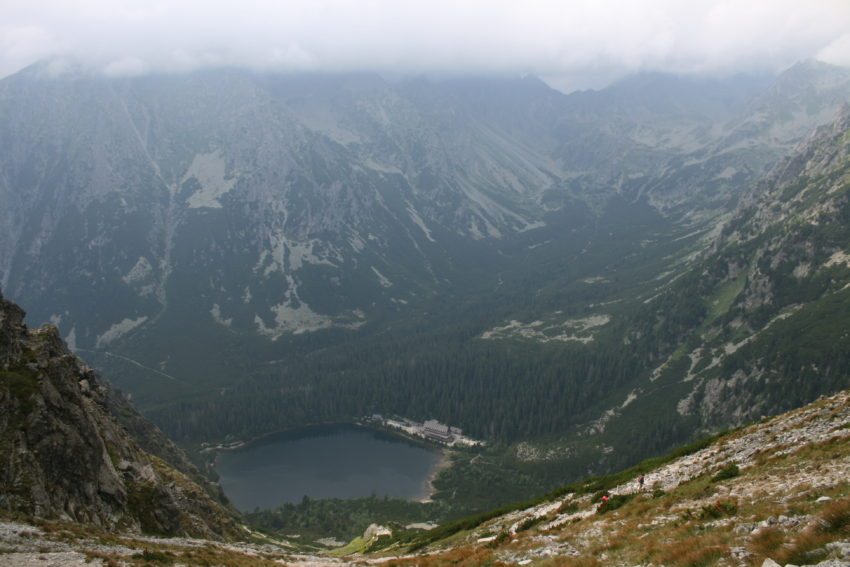
AUG. 19 — POPRADSKE PLESO, Slovakia
OK, Slovakia, you got me.
Forever more I will never look at you as the Czech Republic’s country bumpkin cousin. I won’t think of this region and only think of cold, frothy Pilsner Urquells and brightly lit bridges that make women swoon. I will forever more think of you as giving old planet earth a good name. As man destroys his surroundings around him, Slovakia has maintained a slice of this world that is as flawless as I’ve ever seen. Mother Nature, take a bow. Doff your crown to the Slovaks who have made the High Tatra mountain range one of the most beautiful in the world.
I just finished an eight-hour hike that had my mouth blabbing adjectives at the top of my lungs from high atop Eastern Europe. Yes, eight hours. This was what TravelSlovakia labeled an “easy” hike. Tell that to my thighs. They feel like lead barrels. My shoulders are sagging from carrying a pack up and down an 11-mile ridge. My jogging suit, shorts and T-shirt are drying in this hut’s heated drying room after a torrential downpour that shepherded me down a 1.2-mile mountain. The trail zigzagged down to this gorgeous, crystal-clear lake at the foot of towering rock walls of the same relative grade as elevator shafts.
I am whipped. I’m also exhilarated. The last time I felt this fulfilled from physical exertion was, maybe, 1992 when I stood atop Kilimanjaro at dawn watching the sun rise over Africa. My legs can’t move. But my mind can’t stop. The images of some of the world’s greatest scenery keep rolling through my mind on a continuous loop, like a kaleidoscope of mountains, lakes, waterfalls and valleys.
The hike looked easy enough. Slovak trekking routes are identified by three different lines, red, yellow and green. They’re like subway lines, all equal in difficulty. Today I was to follow the red line from Zamkovshkeho chata to Popradske chata. The red line on my map follows along the southern ridge of the High Tatras. I had the mountains on my right and the vast, green forested rural Slovak countryside to my left. What I didn’t consider was the red line stretched halfway across my map. This was no nature hike. I was covering more than half the breadth of the Tatras, the highest mountain range in Eastern Europe.

For breakfast I loaded up on the carbs. The good rich brown bread that I usually eat with pickles and vodka turns out to be quite tasty without alcohol. I piled salami and cheese onto four pieces of bread while I sopped another in a fried egg. With a big steaming cup of Turkish coffee, I was ready to go.
Hiking alone in strange countries where you don’t speak the language won’t be found in many tourist brochures. Travel agencies have no posters showing a solo backpacker, by himself on a mountain with the emblazoned words, “SEE THE WORLD ALONE! SPEAK TO NO ONE! DON’T GET LOST!” Rick Steves would never dare touch that subject. But I’ve traveled alone for 36 years. There’s something therapeutic about going at my own pace, without discussion, finding my own way. Then, when I reach the crescendo — a gorgeous vista that I didn’t know existed just a few hours before — I don’t need to share it with anyone. I have it all to myself, like a $100 bill found on a curb or the fantastic meal you find in a hole-in-the-wall frequented by no one but the owner’s friends. The only thing better is traveling to romantic spots with a girlfriend. As I sit here in a big airy, mountain cafeteria as brightly lit as Wembley Stadium, I know no girl who would swoon.
Besides, after an eight-hour hike, they’d be in bed not wanting to be disturbed.
When you travel alone, you also meet more people. Locals feel sorry for you, as if your woman just left you (in my case, that has been true) or you’re just plain lost. The questions I get from groups when they see me sitting alone in a restaurant range from the curious, “Why do you like to travel by yourself?” to the juvenile, “I see you’re sitting with all your friends.” I prefer the description of Henrik Ibsen, the old Norwegian playwright, who once said, “The strongest men are the most alone.” Actually, my philosophy is much simpler than that, not to mention more modest.
“When you walk alone it’s never crowded.”
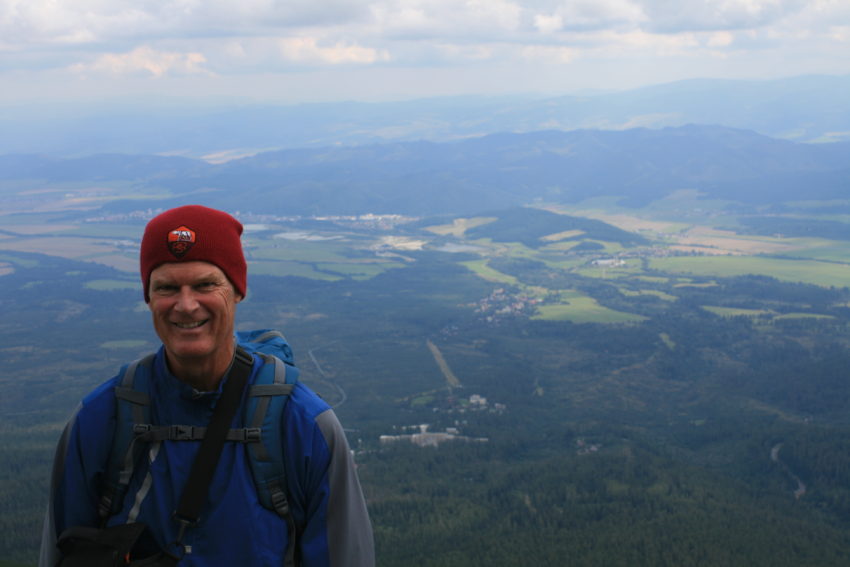
In Slovakia, everyone hikes in groups. Everyone is either Slovak or Czech. I’ve seen two Poles and one group of English whose “Hello” on the trail shocked me off the mountain face. But the Slovaks and Czechs are nice people, such as the young college graduate from Prague whom I passed early on the trail. Tanya (not her real name) had spent seven months in New Zealand and spoke terrific English. She repeated the mantra I keep hearing this week. I asked her if Czech was this beautiful as we took a narrow trail high above the gorgeous green forested valley below.
“Czech has better cities,” she said. “Slovakia has better nature.”
She survived the New Zealand earthquake of 2011, barely. After psychiatric and psychological help, she felt brave enough to travel around New Zealand. I asked her if she tried bungee jumping.
“No,” she said. “After the earthquake, I felt I had run out of luck.”
I thought she was brave to tackle these trails alone. However, she said she’s a slow hiker and always gets a head start on her group. When they caught up, I took off.
The trail was fairly flat but oh, so gorgeous as I worked my way south. In 30 minutes I came across a little wooden bridge overlooking a pretty blue river cascading down from the mountains. Another 15 minutes I came to another place name I can’t pronounce. If you can correctly say Hrebienok pleso on the first try you get a job in the U.N. Hrebienok was about the last sign of organized tourism I’d find today. It had a few picnic tables where middle-aged Slovaks and Czechs were drinking tall glasses of beer. I looked at my watch.
It was 8:15 a.m.
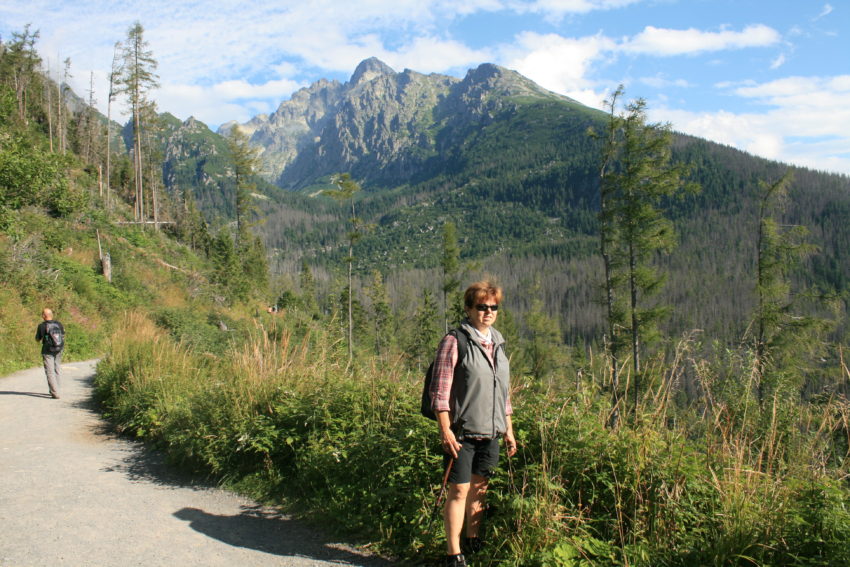
I didn’t even unsheath my water bottle and started the long slog across the face of the valley. On the map it looks like a gentle line separating the high mountains with the green valley, like a fat man’s waistline. What you need is a magnifying glass to see the elevation gains. You realize that gentle line represents a roller coaster jumping up and down the face of the mountains. The path went up a lot more than it did down, sometimes at about a 45-degree angle. Yet the views were absolutely astounding.
To my right, craggy gray cliffs shot up to the heavens, their peaks shrouded by fog. Below me was a forest of trees cascading forever to a deep green valley bordered by lowland hills in the far distance. The only signs of humanity were the occasional Slovaks walking by saying, “AH-hoy” and the scattered buildings of Stary Smokovec, the little town below.
The air was dense. Rain threatened all day. The distant hills weren’t real clear but the sheer magnitude of the vast green carpet kept my engine running.
Slovakia isn’t perfect. I found more wind damage. An entire swath of forest below had been cut down. Only some trunks of some trees were left. It’s as if someone came in with a giant lawn mower and cleared it for a golf course. But the winds only hit a small area and soon my view was an undisturbed carpet of trees.
I did have another trekking companion. As I pranced over boulders and up and down the side of the mountains, an orange, yellow and black butterfly stopped in front of me. I bent down to take its picture but, the most camera shy of insects flew away. However, it didn’t leave completely. It seemed to lead me all the way to my lunch break, a big, ‘90s style ski lift restaurant called Sliesky doro. As if done for the day, like a guide dog, the butterfly flew back from where we met. Curiously, it stopped near my face as if to say, “Good luck, John. Loners occasionally need companionship, too.”

At this ski lift, ski weather came in. A cold wind whipped down the mountain above us as I took bites of schnitzel in between pulling on my sweatshirt and jogging suit and stocking cap. By the time I was done eating, the High Tatras were nearly covered in fog. I looked at the sign post.
I had another five hours to go.
The good thing about cold hiking weather is you never really get tired. You don’t get thirsty. You don’t sweat. The more you hike, the warmer you become. In the High Tatras, where the trail can suddenly shoot up the mountain face at the turn of a corner, I got warm in a hurry. Going west, the traffic became less. This area is too far for day trippers and even Slovaks can’t drink four steins of beer by noon and hike five hours up mountains. Too bad. They missed some astonishing sights. But boy, did I have to work to see them.
At 2:40 p.m., the trail’s upward arc went steep. My gait became slower. My pack seemed heavier. I looked up and saw the zigzag of the switchbacks that mark steep inclines. I remember seeing the famed 21 switchbacks in l’Alpe d’Huez. These switchbacks were steeper. And dark clouds were settling overhead.
I put my head down and headed up. It was a 35-minute jaunt, back and forth, back and forth. But with each back and each forth, the valley below became more vast, more green, more powerful. Two small villages, comprised of no more than a few small houses, what looked like a store and a restaurant, interrupted the expanse.
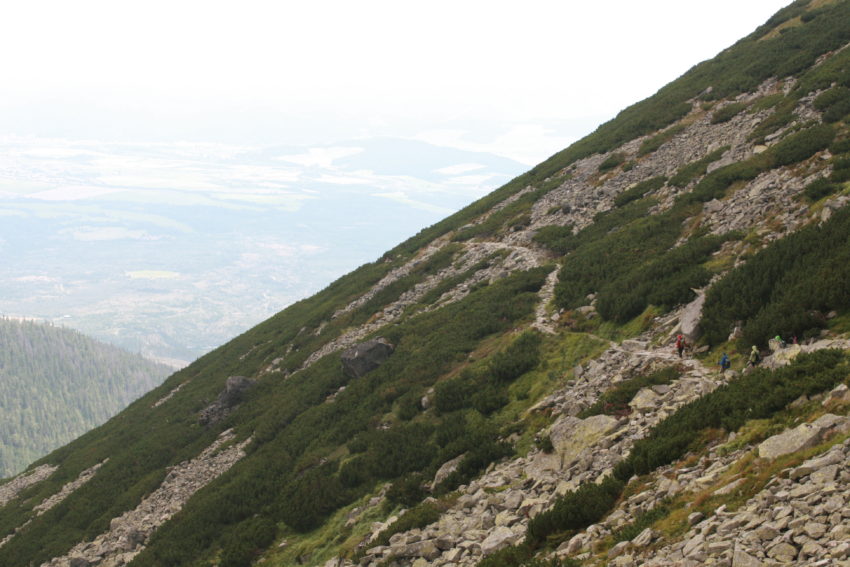
When I reached the top and turned a corner, the valley doubled in size. I could see Slovakia over about a 100-mile stretch. I was mesmerized. I couldn’t move. I’ve seen mountain lakes under snow-capped peaks in the Himalayas and don’t remember doing this: Sticking my arms out to the heavens and, with no one around to hear me, scream, “THIS IS FUCKING GORGEOUS!”
As I lowered my arms, I could hear a faint echo.
Maybe it was the Slovak couple behind me. They were the only people joining me on this long stretch of mountain. I did come across a pretty Czech woman resting on a rock, her gaze glued to the scenery below. She looked fairly young. The fairly young in Eastern Europe all speak English. I took a chance.
“Beautiful, isn’t it?” I said.
“Yes, it’s amazing.”
“Are you coming down or going up?” I said.
“I’m going down to Batizovske pleso.”
“Is the rest of the way to Popradske all uphill?”
“No, it goes downhill.”
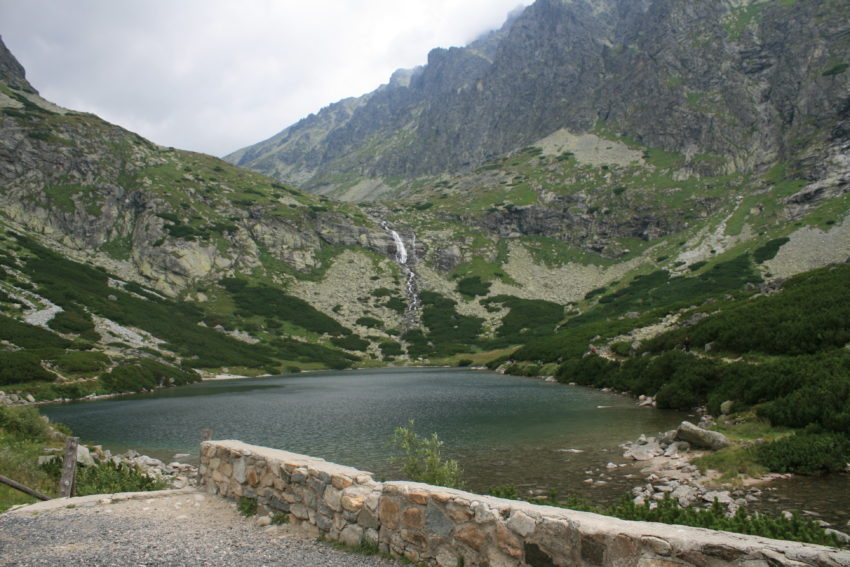
My thumbs shot up in the air like a basketball referee signalling a jump ball. We talked for a bit. She was the perfect rest stop. She’s from Ostrava, Czech Republic, a proud nationalist who loves what Czech Republic has become. I told her that I thought Prague is the third most beautiful city in Europe behind Rome and Paris.
“Prague is mystical,” she said. “It glows.”
“It’s hard to believe Czech Republic was ever a communist country,” I said. “Everything is so bright. Everyone is happy?”
“I’m happy,” she said with a big smile.
As the Slovaks began to pass me, I bid adieu to the last English conversation I’d have today. With the clouds darkening and the day reaching dusk, I wanted someone, anyone, around just in case I take a wrong turn and needed directions to avoid winding up in the Ukraine.
At 3:30 it began to rain. I had packed my rainproof coat and waterproof pants I somehow found in Rome, where hiking is done to reach a caffe or eat a gelato, not for exertion. However, they stayed in my pack. The rain actually felt quite pleasant. I was cool. It soothed my aching joints. Besides, I was too mesmerized by the final descent to be bothered by petty things like warmth. Sedlo pod Ostrvou isn’t a Russian satellite shot down by the Chinese. It’s a 7,537-foot mountain I found myself atop looking at arguably the most beautiful lake of my life.
Popradske pleso sits 1.2 miles down as towering cliffs and lush forests merge around it like hands around an infant. I took some pictures of the Slovak couple who found new strength in their hugs as they gazed below.
While they walked hand in hand into possibly the most romantic vista of their lives, I followed behind. Alone with my thoughts, I pulled out my notepad and jotted down mystic witticisms about how the death of the planet has been greatly exaggerated. In this corner of Central Europe, I have found the perfect confluence of nature and independence. At 58 and retired in Rome, I never felt freer, never felt more fulfilled.
Soon, I’d never feel wetter.
The foreboding dark clouds opened up. The rain came too fast to do anything but pull out the bright yellow backpack cover over my bag. I was already too soaked for any waterproof jacket to help. I desperately dug for my notepad in my soggy jogging pants and tucked them into my cargo shorts underneath. As I switch-backed down the mountain, the lake appeared bigger. So did the lodge where I would spend the night. I arrived soaked like a Soviet guard on winter maneuvers behind the Iron Curtain.
As I type these final words, my fingers are as alive as the images in my camera. My legs underneath can’t move. My shoulders feel like they’re still carrying the backpack, like an amputee who reaches to scratch an arm that no longer exists. But at a lakeside deep in the heart of Eastern Europe, below mountains few outside here have ever seen, I don’t feel so alone.


September 11, 2014 @ 8:02 pm
have you ever bungee jumped?
September 12, 2014 @ 1:11 am
Nope. Never would. I wrote a story about Queenstown, New Zealand, the birthplace of bungee jumping. I went to the top of one of the jumps and interviewed the operators. They say they have no deaths but people with bad backs should avoid doing it. It is quite a jarring jolt to your body. I separated my vertebrae in about 1992. I haven’t had a problem since. I didn’t want to have another one. Besides, it looks scary as hell. I interviewed some people who did it and it’s 24 hours of sheer terror topped by five seconds of near death, followed by a lifetime of relief. I don’t get it.